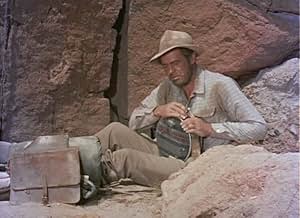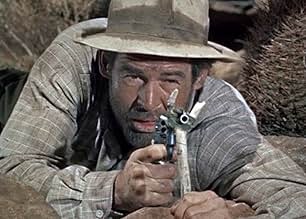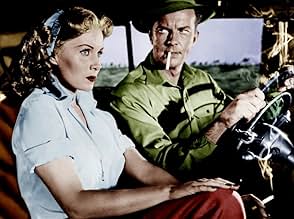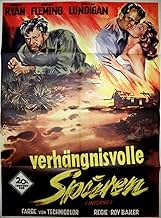VALUTAZIONE IMDb
7,0/10
2011
LA TUA VALUTAZIONE
Aggiungi una trama nella tua linguaA tough, hard-driving business tycoon suffers a broken leg and is left to die in the desert by his scheming wife and her greedy lover.A tough, hard-driving business tycoon suffers a broken leg and is left to die in the desert by his scheming wife and her greedy lover.A tough, hard-driving business tycoon suffers a broken leg and is left to die in the desert by his scheming wife and her greedy lover.
Robert Adler
- Ken - Ranch Hand
- (non citato nei titoli originali)
Harry Carter
- Deputy Fred Parks
- (non citato nei titoli originali)
Everett Glass
- Mason, Carson's Butler
- (non citato nei titoli originali)
James Gonzalez
- Hotel Guest
- (non citato nei titoli originali)
Adrienne Marden
- Emory's Secretary
- (non citato nei titoli originali)
Barbara Pepper
- Waitress
- (non citato nei titoli originali)
Charles Tannen
- Police Radio Broadcaster
- (non citato nei titoli originali)
Dan White
- Lee - Ranch Hand
- (non citato nei titoli originali)
Recensioni in evidenza
In the history of motion pictures only two ideas (as far as I know) failed to catch on in improving the movies we see. One is the laughable "Aroma-vision" that was tried out in the late 1950s with a film that Peter Lorre and Desmond Elliot made called SCENT OF MYSTERY. People just don't like certain odors that can be on the screen in films. But the other was an 3-D, which should have succeeded. If you want to have a more realism in movies, then you should have a movie where depth adds some degree of reality. But 3-D was not used properly. The best recalled uses are in grade z films like ROBOT MONSTER. The best uses of the process were in Alfred Hitchcock's DIAL "M" FOR MURDER, in the Vincent Price horror classic HOUSE OF WAX, and in INFERNO. But while Hitchcock's and Price's films are well remembered (and seen frequently), INFERNO has been generally ignored.
It stars Robert Ryan, Rhonda Fleming, William Lundigan, Larry Keating, and Henry Hull. Ryan begins the film in one of his typically negative characterizations - a millionaire married to Fleming who treats everyone around him as a servant to do his bidding. Sort of like a follow up to his Smith Ohlrig in CAUGHT, only with a new bride. He is going on vacation, and he is accompanied by his wife and a guide played by Lundigan. But Fleming and Lundigan are having a love affair, and when Ryan is injured they realize that they can get rid of him, collect his fortune, and then marry. They leave the obnoxious millionaire in the desert with just a six shooter and a canteen with water. He also has a broken leg. They figure they can report he wandered off, they could not trace him, and in a week the police can find his corpse.
Ryan fools them. Always intelligent in his roles, he growls as soon as he is alone, "They think I'll drink up all my water!" He starts an enforced rationing. He also makes a crutch. Finally he shows his patience in becoming a careful hunter - carefully using his gun to kill game only when it is available. Soon he is able to start following the stars to get back to civilization. And his disappearance is not being casually dismissed by the discovery of his body by the authorities led by Carl Betz. And Fleming and Lundigan are beginning to get nervous - and a bit less lovey-dovey with each other.
But the best part of this film, aside from the careful script and performances, was director Roy Baker's brilliant use of 3-D. He wanted the size of that desert Ryan is marooned in to be really evident to the audience, and his shots of the miles of mesas and sand are deeply impressive. It adds to one's realization of just what Ryan is up against to survive. Actually it was the best use of the process in Hollywood movies, and it makes one regret that John Ford did not think of using the process in say THE SEARCHERS or TWO RODE TOGETHER. Ford's use of "Monument Valley" was always brilliant - imagine if it too had been in 3-D.
It stars Robert Ryan, Rhonda Fleming, William Lundigan, Larry Keating, and Henry Hull. Ryan begins the film in one of his typically negative characterizations - a millionaire married to Fleming who treats everyone around him as a servant to do his bidding. Sort of like a follow up to his Smith Ohlrig in CAUGHT, only with a new bride. He is going on vacation, and he is accompanied by his wife and a guide played by Lundigan. But Fleming and Lundigan are having a love affair, and when Ryan is injured they realize that they can get rid of him, collect his fortune, and then marry. They leave the obnoxious millionaire in the desert with just a six shooter and a canteen with water. He also has a broken leg. They figure they can report he wandered off, they could not trace him, and in a week the police can find his corpse.
Ryan fools them. Always intelligent in his roles, he growls as soon as he is alone, "They think I'll drink up all my water!" He starts an enforced rationing. He also makes a crutch. Finally he shows his patience in becoming a careful hunter - carefully using his gun to kill game only when it is available. Soon he is able to start following the stars to get back to civilization. And his disappearance is not being casually dismissed by the discovery of his body by the authorities led by Carl Betz. And Fleming and Lundigan are beginning to get nervous - and a bit less lovey-dovey with each other.
But the best part of this film, aside from the careful script and performances, was director Roy Baker's brilliant use of 3-D. He wanted the size of that desert Ryan is marooned in to be really evident to the audience, and his shots of the miles of mesas and sand are deeply impressive. It adds to one's realization of just what Ryan is up against to survive. Actually it was the best use of the process in Hollywood movies, and it makes one regret that John Ford did not think of using the process in say THE SEARCHERS or TWO RODE TOGETHER. Ford's use of "Monument Valley" was always brilliant - imagine if it too had been in 3-D.
Inferno is a small but excellent 1953 film about a beautiful woman (Rhonda Fleming) and her lover (William Lundigan) who leave the woman's husband (Robert Ryan) alone in the desert with a broken leg, assuming he'll croak. The story focuses on Ryan's character trying to survive in the desert and what he learns about himself.
With gorgeous Rhonda Fleming in the movie, it's done in color. A chimpanzee could have played her part - there's precious little acting involved - but she certainly adds tremendous beauty to the production. She and another spectacular redhead, Arlene Dahl, both were getting larger roles in films at the time the studio system was winding down. Ten years earlier, they might have ruled the world. William Lundigan is appropriately cold-blooded as her horny lover, and Larry Keating is an appropriately concerned business associate.
But this is Ryan's film, and he's top-notch. His thoughts come over as voice-over, and you're pulling for him every step of the way, despite everyone describing him as unpleasant.
Excellent film, quite a surprise.
With gorgeous Rhonda Fleming in the movie, it's done in color. A chimpanzee could have played her part - there's precious little acting involved - but she certainly adds tremendous beauty to the production. She and another spectacular redhead, Arlene Dahl, both were getting larger roles in films at the time the studio system was winding down. Ten years earlier, they might have ruled the world. William Lundigan is appropriately cold-blooded as her horny lover, and Larry Keating is an appropriately concerned business associate.
But this is Ryan's film, and he's top-notch. His thoughts come over as voice-over, and you're pulling for him every step of the way, despite everyone describing him as unpleasant.
Excellent film, quite a surprise.
The best thing about Inferno is that, like the Aeneid, it jumps right into the middle of the action. Out in a southwestern desert, under the baking sun, lies Robert Ryan, with his leg broken and only a meager supply of food and water. He's been left to die by his wife (Rhonda Fleming) and her lover (William Lundigan). There's no backstory, no lead-up to the crucial events; what little we need to know gets doled out as the movie advances, but never in flashback.
Of course, anybody can be left to die in the desert by a philandering spouse, but it helps if you're a millionaire, like Ryan. We learn that he inherited his fortune and wonders whether he deserves it, and that he's a tough and private man who suffers no fools gladly (the part's basically a reworking of Ryan's Smith Ohlrig in Max Ophuls' Caught).
The rest of Inferno cross-cuts between Ryan's attempts to survive by his wits and Fleming's and Lundigan's to throw the local police and Ryan's business associates back in Los Angeles off track. After several days elapse, when it becomes apparent that Ryan may still be alive and on the move, Fleming and Lundigan decide that, in order to save themselves, they have to go back and finish the job....
Inferno was issued in 1953, the annus mirabilis of 3-D. Unlike most titles filmed in that short-lived gimmick, it stands pretty well on its own even the hurtling rocks, striking rattlers and flaming rafters stay effective without knocking viewers over the head. But basically it's a story of a man born to wealth who, to stay alive, must negotiate a deadly wilderness where money proves worthless. Watching Ryan do so is worth giving Inferno a look.
Of course, anybody can be left to die in the desert by a philandering spouse, but it helps if you're a millionaire, like Ryan. We learn that he inherited his fortune and wonders whether he deserves it, and that he's a tough and private man who suffers no fools gladly (the part's basically a reworking of Ryan's Smith Ohlrig in Max Ophuls' Caught).
The rest of Inferno cross-cuts between Ryan's attempts to survive by his wits and Fleming's and Lundigan's to throw the local police and Ryan's business associates back in Los Angeles off track. After several days elapse, when it becomes apparent that Ryan may still be alive and on the move, Fleming and Lundigan decide that, in order to save themselves, they have to go back and finish the job....
Inferno was issued in 1953, the annus mirabilis of 3-D. Unlike most titles filmed in that short-lived gimmick, it stands pretty well on its own even the hurtling rocks, striking rattlers and flaming rafters stay effective without knocking viewers over the head. But basically it's a story of a man born to wealth who, to stay alive, must negotiate a deadly wilderness where money proves worthless. Watching Ryan do so is worth giving Inferno a look.
This exciting thriller packs a punch as a cheating wife (Rhonda Fleming) and her scheming lover (William Lundigan) purposely abandon her husband with a broken leg in the middle of the Mojave Desert without transportation or supplies. But they're not clever enough by half...as they start their premature gloating and plans to spend his money, the determined husband (grittily played by Robert Ryan) refuses to die and slowly makes his hate-filled way to a spectacular revenge.
I think Robert Ryan is one of the greatest actors of his time and its a shame that he seems to be forgotten in todays movie society, This is am excellent example of Ryans acting prowess and shows how the will to live is so strong despite being betrayed and abandoned in a place with out hope. I would say this is a must see for people interested in Robert Ryans acting and his excellent ability to make it all seem so real. I like the fact that he never gives up despite all the odds thrown against him when adultery alone makes most people lose the will to carry on. I have seen this movie twice now and have been riveted to the TV both times. Years ago having seen Robert Ryan in a few movies I thought he was OK but this movie proves he was much more than that and I look forward to discovering him in his other movies I have yet to see.
Lo sapevi?
- QuizWhen the cast and crew arrived at the Mojave Desert location, it was covered in snow and Rhonda Fleming subsequently developed pneumonia.
- BlooperEarly in the movie, after Robert Ryan has put a splint on his broken leg (which continues to cause him a lot of pain), he takes a small branch and breaks it over the injured leg, seemingly without feeling any pain.
- Citazioni
Donald Whitley Carson III: [after finding water in a cactus] This stuff's a great discovery. Just sit there and work on it all day and you can get enough juice to sit there and work on it all day.
- Versioni alternativeAlso shown in a 3D version.
- ConnessioniFeatured in A New Dimension in Noir: Filming Inferno in 3D (2017)
I più visti
Accedi per valutare e creare un elenco di titoli salvati per ottenere consigli personalizzati
- How long is Inferno?Powered by Alexa
Dettagli
Botteghino
- Budget
- 1.055.000 USD (previsto)
- Tempo di esecuzione
- 1h 23min(83 min)
- Proporzioni
- 1.33 : 1
Contribuisci a questa pagina
Suggerisci una modifica o aggiungi i contenuti mancanti




































